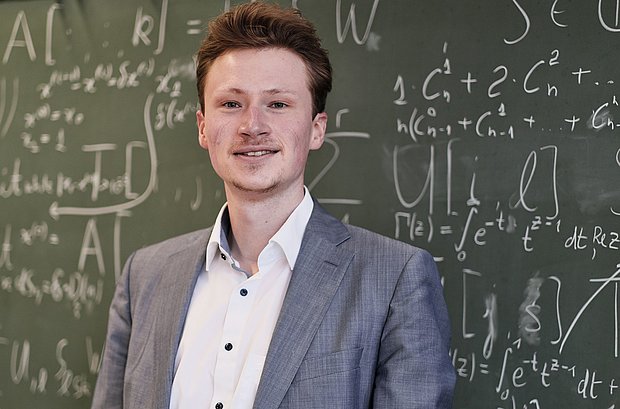
Dr. rer. nat. Andreas A. Buchheit
Building E1 1, Room 4.18
Department of Mathematics
Saarland University
PO 15 11 50
D-66041 Saarbrücken
Tel.: +49 151 2724 6209
E-Mail: andreas.buchheit@uni-saarland.de
GitHub, ResearchGate, LinkedIn
Research Interests
As a research fellow in applied mathematics at Saarland University, I focus on developing innovative numerical methods to address important open problems in theoretical quantum physics, with a particular emphasis on long-range interacting systems.
I lead the development of the Singular Euler–Maclaurin Expansion (SEM), an impactful generalization of the 300-year-old Euler–Maclaurin summation formula to high-dimensional lattices and physically relevant long-range interactions (Nonlinearity 35, 3706 (2022), J. Sci. Comput. 90, 53 (2022)). This work, which synthesizes techniques from analysis, partial differential equations, and distribution theory, has enabled the prediction of novel exotic phases in unconventional superconductors with long-range electron-electron interactions (Phys. Rev. Research 5, 043065 (2023)). I have solved the long-standing challenge of computing lattice sums with boundaries (Math. Comp. (Oct. 2024)), which has immediate applications in the study of topological systems with long-range interactions. In recent work, I have developed a new method that reduces the computation of many-body interaction energies in solids exponentially (arXiv:2504.11989 (2025)). This forms the basis for a rigorous investigation into the influence of many-body interactions on the stability of matter, with first results published in J. Chem. Phys. 163, 094104 (2025).
I also lead the development team for EpsteinLib, the first high-performance library for computing the Epstein zeta function (arXiv:2412.16317 (2025)), a multidimensional generalization of the Riemann zeta function. This library has broad applications in condensed matter physics, high-energy physics, and chemistry, and allows for the precise prediction of properties of long-range lattices.
Teaching
SoSe 25/26 Seminar Numerik in der Quantenphysik
SoSe 2025 Seminar Numerik von Eigenwerten
WiSe 24/25 Seminar Numerische Methoden in stark korrelierten Elektronensystemen
WiSe 23/24 Seminar Computer Algorithms in Applied Mathematics
SoSe 2023 Vorlesung Programmierung
WiSe 22/23 Seminar Numerische Methoden in kondensierter Quantenmaterie
SoSe 2021 Seminar Fourier-Analysis
WiSe 21/22 Seminar Nichtlineare Phänomene verstehen
SoSe 2021 Vorlesung Programmierung
WiSe 19/20 Seminar Numerische Methoden für die Maxwellgleichungen
SoSe 2019 Vorlesung Programmierung
Published Research
[10] Exact lattice summations for Lennard-Jones potentials coupled to a three-body Axilrod–Teller–Muto term applied to cuboidal phase transitions, Andres Robles-Navarro, Andreas A. Buchheit, et. al., J. Chem. Phys. 163, 094104 (2025)
[9] On the computation of lattice sums without translational invariance, Andreas A. Buchheit, Torsten Keßler, and Kirill Serkh, Math. Comp. 94, 2533-2574 (2025)
[8] Exact continuum representation of long-range interacting systems and emerging exotic phases in unconventional superconductors, Andreas A. Buchheit, Torsten Keßler, Peter K. Schuhmacher, and Benedikt Fauseweh, Phys. Rev. Research 5, 043065 (2023)
[7] Singular Euler-Maclaurin expansion on multidimensional lattices, Andreas A. Buchheit and Torsten Keßler, Nonlinearity 35 3706 (2022)
[6] On the Efficient Computation of Large Scale Singular Sums with Applications to Long-Range Forces in Crystal Lattices, Andreas A. Buchheit and Torsten Keßler, J. Sci. Comput. 90, 53 (2022)
[5] On the efficient computation of multidimensional singular sums, Andreas A. Buchheit, Dissertation (2021)
[4] Ground state of the Frenkel–Kontorova model with a globally deformable substrate potential, Andreas A. Buchheit and Sergej Rjasanow, Physica D: Nonlinear Phenomena (2019): 132298
[3] Master equation for high-precision spectroscopy, Andreas A. Buchheit and Giovanna Morigi, Phys. Rev. A 94, 042111 (2016)
[2] Critical Analysis of the Born-Markov Master Equation, Andreas A. Buchheit, Master's thesis (2015)
[1] Dynamik von lasergetriebenen Atomen, Andreas A. Buchheit, Bachelor's thesis (2013)
Preprints
[1] Zeta expansion for long-range interactions under periodic boundary conditions with applications to micromagnetics, Andreas A. Buchheit, Jonathan K. Busse, Torsten Keßler, and F. N. Rybakov, arXiv preprint 2509.26274 (2025)
[2] Non-local edge mode hybridization in the long-range interacting Kitaev chain, David Haink, Andreas A. Buchheit, and Benedikt Fauseweh, arXiv preprint 2509.26447 (2025)
[3] Epstein zeta method for many-body lattice sums, Andreas A. Buchheit and Jonathan Busse, arXiv preprint 2504.11989 (2025)
[4] Computation and properties of the Epstein zeta function with high-performance implementation in EpsteinLib, Andreas A. Buchheit, Jonathan Busse, and Ruben Gutendorf, arXiv preprint 2412.16317 (2025)
Impact and Outreach
[O11] “Dreikörper-Berechnungen: Wo Mathematik auf Netflix trifft” (“Where Math Meets Netflix”), live interview with rbb, RadioEins, ARD Mediathek (2025).
[O10] „Netflix trifft Mathematik: Forscher aus Saarbrücken knacken Dreikörper-Berechnungen“ (Netflix meets mathematics, researchers from Saarbrücken solve three-body computations), IDW, Saarland University News (2025)
[O9] „Mathematik im Grenzbereich: Neue Berechnungsmethode revolutioniert Simulation neuer Materialien“ (Mathematics at the Frontier: New Computational Method Revolutionizes the Simulation of New Materials), IDW, Saarland University News, pro-physik (2024)
[O8] “Simulation of unconventional superconductors”, NHR@FAU Video-Interview (2024)
[O7] „Fernbeziehungen: Langreichweitige Wechselwirkungen in makroskopischen Systemen berechenbar machen“ (Long-Distance Relationships: Making Long-Range Interactions in Macroscopic Systems Computable), Physikjournal 06/24 (2024)
[O6] „Zwei bisher unbekannte Arten von Supraleitern vorhergesagt“ (Two Previously Unknown Types of Superconductors Predicted), Spektrum der Wissenschaft 03.24, p. 32 (2024)
[O5]„Mathematiker und Physiker beschleunigen Simulation von Supraleitern enorm“ (Mathematicians and Physicists Greatly Accelerate Superconductor Simulations), IDW, Saarland University News (2023)
[O4] „Success Story: Simulation of unconventional superconductors”, Erlangen National High Performance Computing Center (NHR@FAU) (2023)
[O3] „Wirkung auf die Ferne berechnen“ (Computing Interactions at a Distance), Spektrum der Wissenschaft 08.22, p. 24 ff (2022)
[O2] „Mathematiker lösen komplexes Problem durch Verallgemeinerung einer 300 Jahre alten Formel“ (Mathematicians Solve Complex Problem by Generalizing a 300-Year-Old Formula), Saarland University Research News, IDW (2022)
[O1] „The Singular Euler-Maclaurin Expansion: A New Twist to a Centuries Old Problem”, Wolfram Blog Entry on the SEM (2021)
